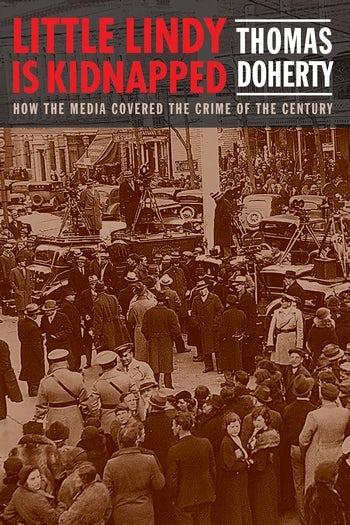In 1927, Charles Lindbergh became the first aviator to complete a solo transatlantic flight, departing from New York and landing in Paris 33 and a half hours later. The trip garnered rabid media attention: Fox Movietone newsreels captured Lindbergh’s takeoff in his now famed monoplane, Spirit of St. Louis, and hundreds of millions of people around the world listened intently as flight updates were broadcast across radio waves. When Lindbergh finally touched ground in Paris, he was greeted by what cultural historian Thomas Doherty calls “an orgy of jubilation.” It is in this moment of “mass hysteria, wild rapture, a nation gone mad,” Doherty writes, that Lindbergh the icon was born.
In his new book, Little Lindy Is Kidnapped: How the Media Covered the Crime of the Century, Doherty — currently a professor of American studies at Brandeis University — traces Lindbergh’s ascent to contextualize the personal (and simultaneously very public) tragedy that would ultimately define his life: the 1932 abduction of his 20-month-old son. The book provides a thorough cultural history of the media coverage of the kidnapping and subsequent trial, and in doing so, captures a critical moment in the evolution of American journalism.
The moment Lindbergh arrived in Paris, he became a media darling. A celebratory reception was held in Washington, DC, following the transatlantic flight, paid for by Hollywood mogul William Fox and produced by entertainment maestro Samuel L. “Roxy” Rothafel. The festivities were broadcast nationwide by the NBC Radio Network, turning the young pilot of the hour into a household name. Lindbergh soon received offers to appear in Hollywood films and go out on a celebration tour, though he rejected these proposals in what appears to be an admirable refusal to cash in on his own fame. Two years after the flight, Lindbergh married Anne Spencer Morrow, daughter of an American ambassador and heir to the Morrow estate, with whom he had a baby boy named Charles Jr., born June 22, 1930. The press covered the birth with celebratory zeal and quickly coined a nickname for the child — Little Lindy.
But the Lindberghs’ lives were soon marred by calamity: on March 1, 1932, at the peak of Lindbergh’s celebrity, Little Lindy was kidnapped from his family’s home in Hopewell, New Jersey. The news spread rapidly across the wire services, as the Associated Press, United Press, and International News Service anxiously reported on the abduction. The entire country became transfixed by the disappearance of the celebrity child. Various news outlets deemed the kidnapping “the Crime of the Century”; some journalists decried it as “a final affront to American civilization” — a tragedy made unbearable by the devastation of the Great Depression, which was already at its worst.
